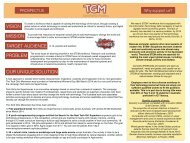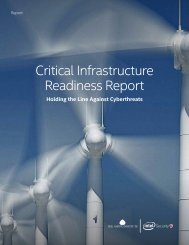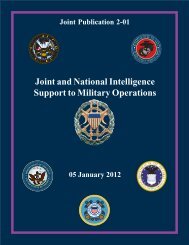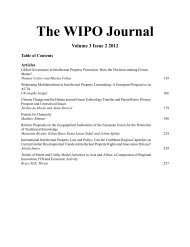Transparency Initiative (EITI)
2eoch1l
2eoch1l
You also want an ePaper? Increase the reach of your titles
YUMPU automatically turns print PDFs into web optimized ePapers that Google loves.
47<br />
5.2.3 ANTI-CORRUPTION<br />
es membership status when such data is being made available.<br />
The report indicates that government and non-governmental<br />
stakeholders use mining sector revenues for their<br />
purposes such as forecasts, budget planning or advocacy<br />
activities.<br />
In contrast, Acosta emphasises that a “lack of stakeholder<br />
leadership, the exclusion of key social actors, or pre-existing<br />
institutional constraints such as weak accountability<br />
and oversight institutions” or “the absence of sufficient<br />
channels of communication” might endanger public debate<br />
(Acosta 2013: 100). The Scanteam 2011 report also<br />
points out, using the example of Nigeria, that just the provision<br />
of information is not sufficient for public discourse<br />
(p.24). While media and civil society organizations might<br />
forward key messages to the public, particularly CSOs appear<br />
to miss a viable strategy “for holding the public sector<br />
accountable for the use of the revenues”.<br />
Another obstacle for public debate, reported from Azerbaijan,<br />
is the lack of interest of the population in the information<br />
offered by the <strong>EITI</strong> as it does not recognize the “direct<br />
and positive links between the <strong>EITI</strong> and the living standards”,<br />
which makes it difficult to engage people in discussions<br />
or motivate them to disseminate information even on<br />
a local level (Wilson 2014: 26, referring to Ahmadov/Wilson<br />
2012). It can be noticed that in recent years the crack-down<br />
on civil society in the very case of Azerbaijan and an overall<br />
global shrinking of civic space in autocratic regimes and<br />
deficient democracies has led to the introduction of the<br />
<strong>EITI</strong> Civil Society Protocol in 2015, in order to safeguard<br />
NGOs and civil society participation in the <strong>EITI</strong>.<br />
NON-SPECIFICALLY ON THE <strong>EITI</strong>:<br />
In contexts, where freedom of expression and assembly is<br />
restricted, it may be even harder to engage the general public.<br />
Mildner/Lauster (2011: 100) refer to Shaxon (2009), who<br />
points out that “direct pressure can be counter-productive<br />
and rejected” particularly under politically fragile and autocratic<br />
framework conditions such as in Angola (which is<br />
not an <strong>EITI</strong> implementing country).<br />
``<br />
Limited evidence to which extent the <strong>EITI</strong> contributes<br />
to anti-corruption and improved public financial management.<br />
A number of anecdotal references and hints<br />
are offered.<br />
COVERING THE STANDARD 2013:<br />
The only study, which concretely focuses on the connection<br />
between transparency and corruption and provides<br />
evidence on that issue, is the one from Etter (2014), which<br />
is based on two in-depth case studies in Peru and Mali. The<br />
study indicates “a robust reduction of corruption in Peru,<br />
where corruption has been reduced by as much as 14 percentage<br />
points [perceived as a business obstacle by surveyed<br />
companies] since the introduction of the <strong>EITI</strong>, while<br />
no such effect [was] found in Mali.” Thereby, Etter ascribes<br />
this controversial finding to the differences of the countries’<br />
civil societies, whose functionality is regarded as an<br />
essential prerequisite for the effectiveness of the initiative<br />
in that regard.<br />
Bickham (2015), based on recent empirical findings from<br />
interviews and surveys with the industry, MSGs, implementing<br />
and supporting governments and further stakeholders,<br />
provides a rather scattered picture. In conclusion<br />
(p. 29ff), there is still room for improving the effectiveness<br />
of the initiative regarding its contribution to better public<br />
financial management, e.g. by intensified involvement<br />
of the industry or strengthening public administration capacities.<br />
Neumann (2014: 9) summarizes literature and documents<br />
on the basis of three country case studies from Nigeria, DRC<br />
and Sierra Leone. He finds that the <strong>EITI</strong> appears to be related<br />
to increasing governmental revenues through revealing<br />
discrepancies of tax payments. He however also states that<br />
the data does not allow conclusions about the contribution<br />
of the <strong>EITI</strong> to the developments in these countries, as they<br />
might be confounded or even vice-versa related.<br />
Furthermore, at least anecdotal references can be found in<br />
the <strong>EITI</strong> progress reports, which contain a number of examples<br />
that <strong>EITI</strong> reports have revealed cases of fraud and<br />
corruption as for instance in Nigeria (<strong>EITI</strong> 2014: 25; 2013:<br />
25, 32), Liberia (<strong>EITI</strong> 2014: 27; 2011: 14) or the DRC (2014:<br />
21).<br />
BEFORE THE STANDARD 2013:<br />
Using the example of Nigeria, the Scanteam 2011 (p. 12)<br />
report also rates the “lack of a systemic link between N<strong>EITI</strong><br />
activities and approaches to larger PFM [Public Finance









